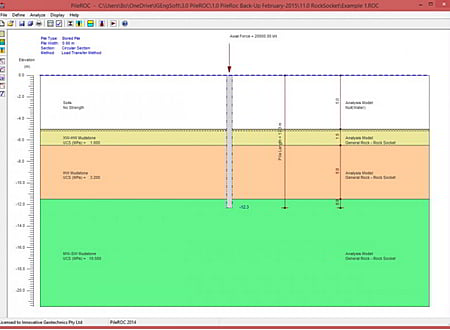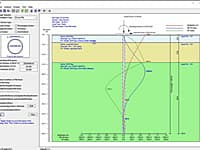PileROC 2014 is a program that predicts the load settlement curve at the pile head for the piles socketed into rock based on three commonly-used methods:
- Fleming (1992)’s method;
- Kulhawy and Carter (1992)’s method
- Load transfer method with using t-z and q-w curves.
PileROC 2014 is a useful tool to estimate the load settlement curve at the pile top for rock sockets. It is a must-have tool for rock socket design and analysis by geotechnical engineers. Some of the Features and Benefits are as follows:
- Standard window-style dialogs, push buttons, drop menus, list boxes, EXCEL-like data grid cells, slide bars, radio buttons, check boxes and toolbars can be accessed in the program;
- Three commonly-used Rock Socket Design Methods are available in PileROC 2014 program: (1) Fleming (1992)’s method; (2) Kulhawy and Carter (1992)’s method and (3) Load transfer method based on t-z and q-w curves;
- For load transfer method, nonlinear t-z and q-w curves are automatically generated for rocks. Generated t-z curves for each node and q-w curve at the pile toe location can be viewed, copied and printed. No need to specify the node locations before the analysis in order to access the t-z and q-w curve information. Once the analysis is completed successfully, t-z curves for all the nodes and q-w curve at the pile toe location are automatically available to the user;
- Resistance factors can be specified by the users for ultimate shaft resistance (compression), ultimate shaft resistance (tension) and ultimate end bearing resistance for the design to be consistent with the current widely-used limit state design concept;
- Detailed analysis results are presented in EXCEL-like format and can be easily selected and copied into the third-party program such as EXCEL for further processing;
- An Interactive Graphical Presentation Dialog of pile and soil layer geometry is provided. Important changes in the input data such as pile length, the number of soil layers, soil layer name, soil layer thickness, soil layer color, analysis model type, water table position, certain soil parameters and pile loading will be automatically updated in the main graph. It is very convenient for the user to visually view the input change;
- Innovative soil layer and parameter input dialog is provided to help the user to enter the input data more easily and smoothly. The user can easily add, delete, insert or modify the input parameters for each rock layer according to the material type. Important changes in the input data will be automatically updated in the graph on the main program once the input dialog is closed;
- Load-settlement curve can be generated by the program for the specified axial loading at the pile head. Relevant information such as ultimate shaft resistance, ultimate end bearing resistance, ultimate axial pile capacity and rock socket design method are shown on the load-settlement curve graph for the specified rock socket length for quick reference.
* PileROC download link provides demo version of the software.
Behaviour Of Single Piles Under Axial Loading
PileAXL is a program that analyzes the behaviour of single piles under axial loading applied at the pile head for both onshore and offshore engineering problems.
Nonlinear Analysis of Pile Groups Under General Loading
PileGroup calculates the deformations and loads of pile groups subject to general three-dimensional loadings such as axial and lateral forces and moments applied on the pile caps.
Behaviour Of Single Piles Under Lateral Loading
PileLAT is a finite-element based program that analyzes the behaviour of single piles mainly under lateral loading based on p-y curves.
Deep Foundation Analysis and Design Solutions
PileSuite is a powerful suite of software products for deep foundation analysis and design for both onshore and offshore projects.
Study of Drilled Shafts under Axial Loading
SHAFT is a computer program used to evaluate the axial capacity and the short-term, load-settlement curves of drilled shafts or bored piles in various types of soils.
Submit a review about PileROC software with your social media profile







No comments yet. Be the first to comment.